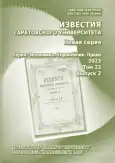Evolution and development trends of the world monetary and fi nancial system
- Authors: Naidenova N.V.1
-
Affiliations:
- Saratov State Law Academy
- Issue: Vol 23, No 2 (2023)
- Pages: 153-162
- Section: Articles
- URL: https://journals.rcsi.science/1994-2540/article/view/252066
- DOI: https://doi.org/10.18500/1994-2540-2023-23-2-153-162
- EDN: https://elibrary.ru/IYFGCS
- ID: 252066
Cite item
Full Text
Abstract
About the authors
Nataliia Vladimirovna Naidenova
Saratov State Law Academy1, Volskaya str., Saratov, 410056, Russia
References
- Витте С. Ю. Избранные воспоминания, 1849–1911. М. : Мысль, 1991. 708 c.
- Струмилин С. Г. Очерки экономической истории России и СССР. М. : Наука, 1966. 513 с.
- Международный валютный фонд : [сайт]. URL: https://www.imf.org/ (дата обращения: 31.01.2023).
- ОЭСР. Статистика : [сайт]. URL: https://stats.oecd.org/# (дата обращения: 27.01.2023).
- Министерство финансов США : [сайт]. URL: https://home.treasury.gov/ (дата обращения: 02.02.2023 ).
- Совет управляющих Федеральной резервной системы. URL: https://www.federalreserve.gov/ (дата обращения: 07.02.2023).
- Экономические данные Федерального резерва. URL: https://fred.stlouisfed.org/ (дата обращения: 02.02.2023).
- Статистический обзор мировой энергетики от BP за июнь 2022 года. URL: http://www.bp.com/statisticalreview (дата обращения: 07.02.2023).
- Россия и страны мира. 2022 : стат. сб. / Росстат. М., 2022. 400 с.
- Евразийская экономическая комиссия. Статистика ЕАЭС. URL: https://www.eurasiancommission.org/ru/act/integr_i_makroec/dep_stat/union_stat/Pages/default.aspx (дата обращения: 07.02.2023).
- Заседание Международного дискуссионного клуба «Валдай», 27 октября 2022 г. URL: https://www.kremlin.ru/events/president/news/69695 (дата обращения: 07.02.2023).
Supplementary files









